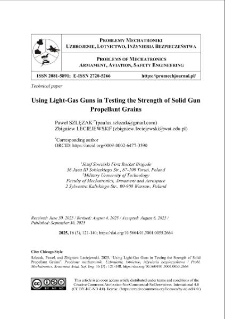Our Digital Library contains 1 868 digital objects
Object
Title: Using Light-Gas Guns in Testing the Strength of Solid Gun Propellant Grains
Alternative title:
Zastosowanie dział gazowych w badaniach wytrzymałościowych ziaren stałych materiałów miotających
Contributor:
Abstract:
NATO Standardisation Agreements (STANAGs) 4241 and 4496 outline destructive testing procedures to determine how gun propellants in artillery munitions behave when struck by a 12.7 × 99 mm anti-tank projectile travelling at approximately 850 m/s, or by a standardised fragment (shrapnel) made from specific material and shape, moving at 1830 or 2530 m/s. Unlike traditional live-fire testing of complete munitions at test ranges, it is now possible to theoretically simulate the results of collisions between objects with specified dimensions, mass, and velocity, whether they involve individual grains or gun propellants (charge) confined within a shell case. These simulations, however, require detailed knowledge of the strength properties of propellant grains under both static and dynamic loading conditions, particularly at the high rates of deformation that can be generated in laboratory experiments using the Taylor impact test or the Split Hopkinson Pressure Bar (SHPB) method. A light-gas gun is often used in these experimental setups, propelling the test specimen by means of energy from compressed gas, such as hydrogen, nitrogen, or helium. Based on the author’s experience with maintaining a straight-line trajectory for expelled propellant grains, as well as ensuring a parallel contact plane between the grain’s leading face and the fixed partition, a new testing approach has been proposed. This approach uses the direct impact Hopkinson Pressure Bar (DIHPB) technique. Of the various Hopkinson methods available, DIHPB was selected. In this method, a propellant grain is attached to the output bar’s face, and the striker impacts the grain’s front face. Strain gauges on the output bar measure the crushing force. The deformation of the propellant grain is then tracked using a non-contact measurement setup (digital image correlation, or DIC).
Place of publishing:
Warszawa
Publisher:
Date created:
Date submitted:
Date accepted:
Date issued:
Extent:
Identifier:
oai:ribes-88.man.poznan.pl:2745
Call number:
Electronic ISSN:
Print ISSN:
Language:
License:
Rights holder:
Starting page:
Ending page:
Volume:
Journal:
Keywords:
Object collections:
Last modified:
Oct 17, 2025
In our library since:
Oct 17, 2025
Number of object content hits:
0
All available object's versions:
https://ribes-88.man.poznan.pl/publication/3086
Show description in RDF format:
Show description in OAI-PMH format:
| Edition name | Date |
|---|---|
| Using Light-Gas Guns in Testing the Strength of Solid Gun Propellant Grains | Oct 17, 2025 |
Objects Similar
Patryk MODRZEJEWSKI Jacek JANISZEWSKI

